Victorian Grain Cropping Soils - Vertosols
Back to: Soils of Victorian Grain Cropping Regions
| Vertosols are clay soils (>35% clay throughout) that display significant shrinking and swelling during wetting and drying cycles. Extensive soil cracking, including at the surface, is a key feature. Slickensides are also often evident in subsoil horizons. Gilgai ('crabholey') microrelief is commonly associated with these soils. Vertosols often have self-mulching surfaces, although more coarsely structured surface soils also occur. Subsoils are often sodic and can be calcareous at depth, usually with visible free calcium carbonate (lime). Subsoil variability is often a feature due to the shrinking and swelling nature of these soils. | 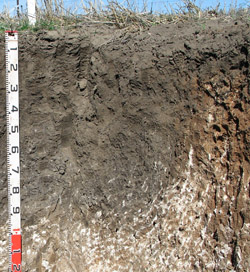 Grey Vertosol at Longerenong displaying considerable subsoil variability |
| In the Australian Soil Classification (Isbell 2002), Vertosols can be distinguished based on the nature of the surface horizon (e.g. Self-mulching, Epipedal, Crusty) and the colour and chemical properties of the subsoil horizons. Based on colour of the upper 50 cm of the soil profile, they can be grouped into suborders (Grey, Red, Brown or Black). | 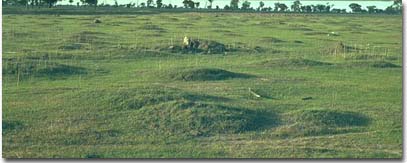 Gilgai microrelief in a paddock near Horsham |
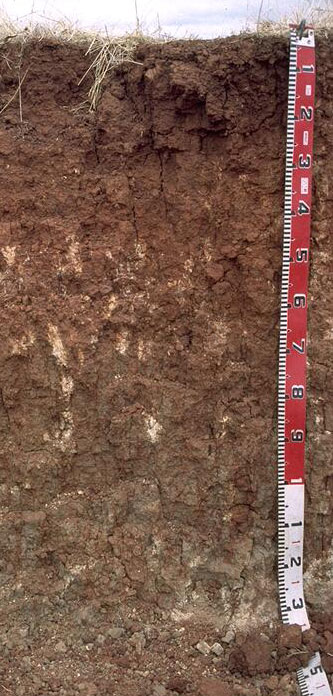
Red Vertosol near Longerenong
Distribution
| Vertosols are a dominant soil in the Wimmera region. They typically occur on level to gently undulating gilgaied plains associated with parent sediments that are mainly alluvial and aeolian (windblown) clayey materials. Grey Vertosols are the most common, with minor occurrences of Red and Brown Vertosols. Where they occur on alluvium, along creeks and rivers, or lake bed deposits, Vertosols usually have coarsely structured (Epipedal) surface horizons (mainly occurring on plains south of the Wimmera River). Self-mulching Vertosols are common in the Horsham and Kaniva regions. Soil pit site WCSS3 is an example of a Grey Vertosol at Longerenong. In the Mallee region, Vertosols typically occur on lake beds, along creeks and rivers as well as on broad low-lying plains to the south. | 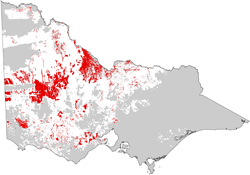 |
In the northern plains of Victoria, Grey Vertosols predominate on the large floodplains associated with the Murray and Loddon Rivers, whilst other streams have smaller occurrences. Grey Vertosols are most common in this region, but Red and Brown subsoils also occur. Soil pit site GN8 is an example of a Grey Vertosol near Dookie.
In south-west Victoria, Vertosols can occur on basalt plains and rises as well as on some alluvial plains, swamps and lunettes. In many areas they can be difficult to map at this statewide scale as they occur as minor components in many landscapes. Black and Grey Vertosols occur throughout the basalt plains and often have self-mulching surfaces, although more coarsely structured surface soils also occur. Subsoils are often sodic and can be calcareous at depth. Black Vertosols commonly occur on broad crests and upper slopes in the Merino Tablelands to the west. Soil pit site SW108 is an example of a Black Vertosol near Mt Gellibrand.
Management Considerations
The surface of Vertosols can often be sodic and disperse significantly after remoulding. This indicates that tillage or overstocking of the soil whilst in a moist to wet condition may result in structural degradation (e.g. surface sealing, increased cloudiness, pugging). Gypsum application may assist in improving surface soil structural condition on such soils. The subsoil can often be sodic and coarsely structured, which will restrict root and water movement. Waterlogging is likely in wet seasons.
The surface condition of Vertosols is an important management consideration. Epipedal and self-mulching Vertosols differ with respect to surface soil friability, pH, profile salinity and clay mineralogy. Self-mulching Vertosols are more friable and easy to work and provide most favourable seedbed conditions. They are extensively cropped for cereals and also support many legumes and oilseed crops. Epipedal Vertosols have coarser structured and more dense surface soil and usually have less well developed gilgai formation.
These high clay soils have a high wilting point value, indicating that plants will not be able to fully utilise light rains falling on relatively dry soil, as there will be insufficient moisture to wet the soil above the wilting point. This may result in moisture stress to plants in a dry spring. When the soil is dry, heavy rains will move down soil cracks. This rapid recharge can be valuable for the survival of plants near wilting. When wet, the soil will swell and further infiltration of water will be relatively slow.
Physical disturbance of cracking clay soils should be avoided if the soil is wet (i.e. wetter than the plastic limit). At such moisture conditions, tillage or excessive trafficking or overstocking could result in structural damage (e.g. compaction, smearing) occurring. Ideally, tillage and trafficking should take place on cracking clay soils when the soil is drier than the plastic limit, down to at least the tillage depth. See further details on compaction in the Soil health section of the VRO website.
The subsoil of Vertosols can often be strongly alkaline, particularly in northern Victoria and on some soils developed on basalt in south-west Victoria. This indicates that phosphorus and some trace elements such as iron, manganese, zinc and copper may be poorly available to plants and deficiencies may occur. Deficiencies can be determined by plant tissue analysis. Boron toxicity can also occur in strongly alkaline soils.
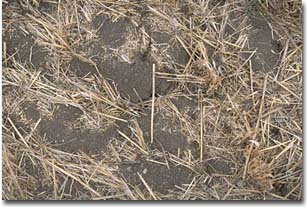 Self-mulching surface condition | 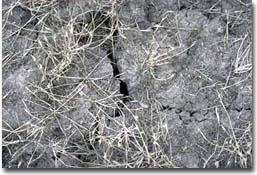 Epipedal surface condition with distinct craking |


